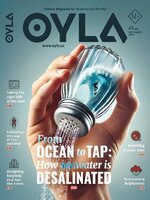OYLA Magazine is a science and technology publication for readers aged 12 and up. It features engaging articles, interactive content, and stunning visuals designed to inspire curiosity and a love for learning. Ideal for young minds eager to explore and understand the world around them.
OYLA Magazine
It’s a Progression, Carl! • What is the total sum of numbers from 1 to 100? One day, a seven-year-old boy named JOHANNA CARL FRIEDRICH GAUSS baffled his arithmetic teacher by solving this difficult problem within seconds. When he grew up, Gauss went on to become an outstanding scientist and earned the unofficial title of Prince of Mathematics. This journey of thousands of miles began with a small discovery back at school. So what was it that Carl invented?
WHY DON’T PLANETS HAVE GAS MOONS? • Most of the planets in our solar system have satellites—all kinds of them. There are small, shapeless moons, like Mars’s Phobos and Deimos; spherical, rocky bodies like our Moon; then there is Saturn’s icy moon Enceladus, and so on. But despite their numbers, there’s not a single gas moon! Moreover, only one of the moons in our solar system has an atmosphere: Triton, one of Saturn’s satellites. Why is it that there are gas planets, but not gas moons?
Picturing the Invisible • In April 2019, the first-ever image of a black hole at the centre of the Messier 87 (M87) galaxy captured global attention. However, some audiences, spoiled by numerous photos from the Hubble Space Telescope, were not impressed by the blurry orange “doughnut.” Why didn’t our massive telescopes capture the black hole earlier? The truth is, none of them can actually “see” it at all!
Hunting for the Beacons of the Universe • Astronomers and astrophysicists have their own “favourite” stars: variables called Cepheids. What makes these stars special? It’s simple: the distances to Cepheids can be relatively easily determined, which is why these stars are sometimes called the “beacons of the universe.” They not only illuminate distant corners of the cosmos but also serve as a beacon for mapping our place in the vast universe.
How Field OBSERVATIONS ARE CONDUCTED • Nowadays, most biologists work in laboratories using complex instruments, test tubes, and Petri dishes, with lab mice, fruit flies, or zebrafish as their only living subjects. However, biology wasn’t always this way, and even now, it isn’t entirely confined to labs. Field observations of living creatures have existed since ancient times and continue to this day. Like other methods, these observations follow specific rules and procedures.
SURVIVAL CHAMPIONS • Of all known planets, Earth stands out as the friendliest to life. Our planet’s atmosphere is rich in oxygen, there is plenty of water on its surface, and it has just the right temperature for life to emerge. Most living organisms in our biosphere prefer to live in places that meet all these conditions. However, there are creatures whose evolutionary paths led them to inhabit spaces that most other living beings wouldn’t survive. Such organisms are known as extremophiles.
HOW TO CARE FOR A SCRAPED KNEE • Children aged 2 to 14 experience an average of 104 minor injuries each year. These injuries are most often grazes on the knees, bumps on the head, and cuts on the fingers. While nearly everyone has scraped their knee at some point, not everyone knows how to treat this type of wound properly. The good news is that most scraped knees can be treated at home.
BAD ADVICE: HOW TO GROW SUPERBUGS TO END HUMANITY • If people don’t stop the reckless use of antibiotics, soon our planet will be overtaken by swarms of deadly superbugs that will make the plague seem like a mild cold. To hasten the end of humanity, all you have to do is follow the bad advice from this article.
THE RACE FOR FOOD: Beating Pests to the Punch • Fruits and...

 November 2024 #48
November 2024 #48
 October 2024 #47
October 2024 #47
 September 2024 #46
September 2024 #46
 August 2024 #45
August 2024 #45
